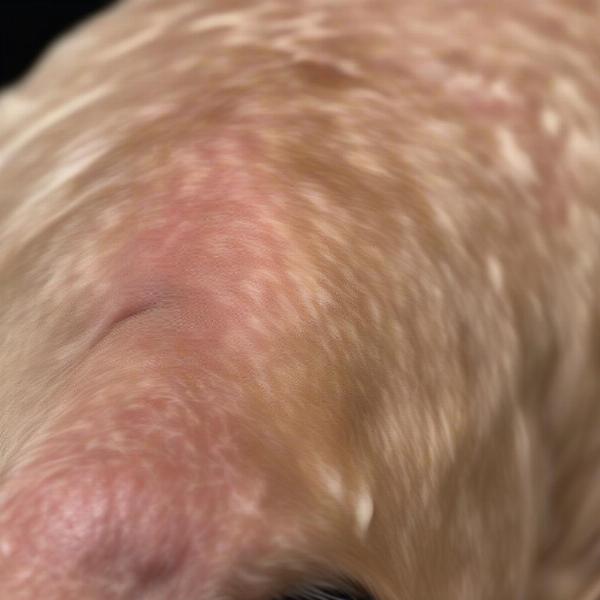Calcinosis cutis in dogs is a skin condition characterized by the deposition of calcium salts in the skin and subcutaneous tissues. While it can appear alarming to pet owners upon discovering these unusual lumps and bumps, understanding the causes, diagnosis, and treatment options can empower you to effectively manage this condition in your canine companion. This article aims to provide comprehensive information on calcinosis cutis in dogs, including visual aids for identification and practical advice for concerned owners.
What is Calcinosis Cutis in Dogs?
Calcinosis cutis can manifest in several forms, each with varying underlying causes. Dystrophic calcinosis cutis is the most common type, typically occurring secondary to inflammation, trauma, or tumors. Other forms include metastatic calcinosis cutis, resulting from high blood calcium levels, and idiopathic calcinosis cutis, which arises without a known cause and is often seen in young dogs, especially certain breeds like German Shepherds. Identifying the specific type is crucial for effective treatment. The condition can present as firm, white or yellow nodules, plaques, or crusts on the skin. These deposits can sometimes ulcerate and cause secondary infections.
Diagnosing Calcinosis Cutis
If you notice any unusual skin changes in your dog, consulting a veterinarian is crucial. The diagnosis of calcinosis cutis typically involves a combination of physical examination, fine-needle aspiration, and biopsy. Fine-needle aspiration allows the veterinarian to collect a sample of the affected tissue for microscopic examination. A biopsy provides a larger tissue sample, allowing for more detailed analysis. Additional blood tests may be necessary to rule out underlying systemic conditions contributing to the calcinosis.
Treating Calcinosis Cutis in Dogs
Treatment for calcinosis cutis varies depending on the underlying cause and the severity of the condition. For dystrophic calcinosis cutis, addressing the primary cause, such as managing inflammation or removing a tumor, is essential. In cases of metastatic calcinosis cutis, managing the underlying hypercalcemia is paramount. Idiopathic calcinosis cutis often resolves spontaneously, but topical medications or surgical removal of the lesions may be necessary in some cases.
Managing Calcinosis Cutis at Home
While veterinary care is essential for diagnosis and treatment, owners can play a crucial role in managing calcinosis cutis at home. Keeping the affected area clean and dry can prevent secondary infections. Monitoring the lesions for any changes in size, color, or texture is important and should be reported to the veterinarian promptly. In some cases, your veterinarian may recommend specific topical treatments or dietary changes to support your dog’s overall health and skin condition.
Frequently Asked Questions about Calcinosis Cutis in Dogs
-
Is calcinosis cutis painful for dogs? While the lesions themselves may not always be painful, ulceration and secondary infection can cause discomfort.
-
Is calcinosis cutis contagious? No, calcinosis cutis is not contagious to other animals or humans.
-
Can calcinosis cutis be prevented? Preventing dystrophic calcinosis cutis involves minimizing trauma and promptly treating skin infections. Metastatic calcinosis cutis prevention focuses on managing underlying diseases that cause hypercalcemia.
-
What breeds are predisposed to idiopathic calcinosis cutis? German Shepherds, especially young ones, seem to be more prone to this form of the condition.
-
What is the prognosis for dogs with calcinosis cutis? The prognosis depends on the underlying cause and the severity of the condition. Many cases, especially idiopathic calcinosis cutis, resolve with minimal intervention.
 Healthy Dog Skin After Calcinosis Cutis Treatment
Healthy Dog Skin After Calcinosis Cutis Treatment
Conclusion
Calcinosis cutis in dogs is a manageable condition, especially with proper diagnosis and treatment. While the sight of these skin lesions can be concerning, understanding the different types, causes, and treatment options can help you navigate this condition effectively with your veterinarian’s guidance. By working closely with your veterinary team and following their recommendations, you can ensure your canine companion receives the best possible care and enjoys a comfortable life.
ILM Dog is a leading international pet website dedicated to providing expert advice on dog care and wellbeing. We offer a wealth of resources on breed selection, health, training, nutrition, grooming, and more. Our team of experts is committed to helping you provide the best possible care for your furry friend. For personalized advice on your dog’s health and well-being, contact us at [email protected] or call us at +44 20-3965-8624. Visit ILM Dog for more valuable information and expert tips on all things dog-related.